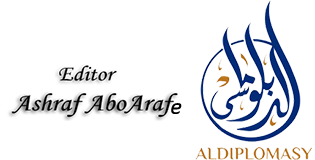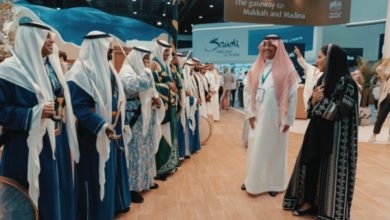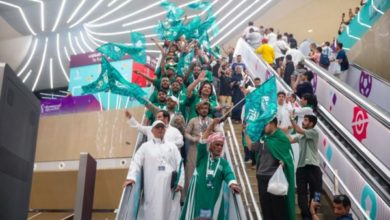Serving the Two Holy Mosques.. An honor and since the era of the founding king.. The Kingdom and the Hajj, an exceptional success story
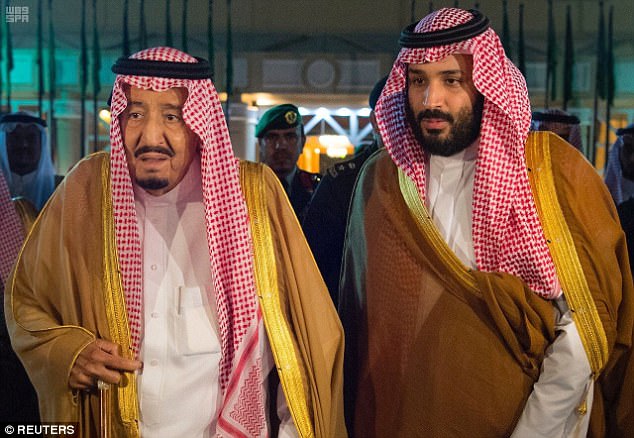
Ashraf AboArafe
· The Guests of God service program integrates with 70 entities to enrich and deepen the Hajj and Umrah pilgrims’ experience
· City Visions: a project with international standards that will serve 30 million pilgrims by 2030
· The Saudi Corridor is a modern development and a historical transformation in the expansion of the Grand Mosque
Since the dawn of Islam and its illumination of the east and west of the earth, Hajj has had a high status among Muslims, which God Almighty instilled in their hearts. Thus, the journey of Hajj, arriving at Mecca, looking at the Holy Kaaba, and standing in the holy sites, became clear; The goal of every Muslim and the wish of every believer. Therefore, serving the Two Holy Mosques is one of the most important priorities of the leadership of the Kingdom, which the kings of this pure country are honored with, and a duty that they devote themselves to performing in order to draw closer to God and fulfill their pioneering and leadership role in serving Islam and Muslims. Throughout successive eras, they have endeavored to provide means of comfort. Facilitating Hajj and visitation matters, facilitating all procedures, and providing the finest services so that the guests of God can perform their worship in spirituality, ease, ease, security, and safety.
Successive expansions
The successive Saudi expansions in the Grand Mosque from the era of King Abdulaziz, may God have mercy on him, until the prosperous era of the Custodian of the Two Holy Mosques King Salman bin Abdulaziz Al Saud and His Highness the Trustworthy Crown Prince – may God protect them – had a significant role and impact in accommodating the steadily increasing numbers of millions of guests of God, including pilgrims, Umrah pilgrims and worshipers. Year after year, the total area of all expansions reached (750) thousand square meters, in order to accommodate no less than one hundred and five thousand worshipers per hour, in addition to more than three million worshipers, which indicates the keenness of the kings of the Kingdom, starting from its founder, to provide every… What is in service to the true Islamic religion and the Holy House of God.
Since the time of the founder
In the year 1344 AH, the founding King Abdul Aziz bin Abdul Rahman Al Saud – may God have mercy on him – ordered the complete restoration of the Grand Mosque and the repair of everything that required repair, as well as the plastering of the entire mosque. In the year 1345 AH, he ordered that pavilions be placed in the courtyard of the mosque to protect the worshipers from the heat of the sun. He also ordered – may God have mercy on him – in the year 1346 AH another repair of the Grand Mosque, which included restoration and painting. He also repaired the Canopy of Abraham, the Dome of Zamzam and the Shadhrawan of the Holy Kaaba.
At the beginning of the year 1373 AH, King Saud – may God have mercy on him – ordered the installation of a pump to raise Zamzam water. A year later, in 1374 AH, he ordered the construction of a building to irrigate Zamzam in front of the Zamzam well. In the year 1375 AH, he ordered that the six candlesticks in the stone of Ismail, peace be upon him, be replaced with electric lights. He also ordered – may God have mercy on him – to pave Land of endeavor.
In the year 1375 AH, King Saud delivered his historic speech initiating the expansion of the Grand Mosque, which was ordered by the founder – may God have mercy on him – and work began on the 4th of Rabi’ al-Akhir in the year 1375 AH. This expansion included three floors, namely the basements, the ground floor, and the first floor, with the Masa’a being built with two floors and an expansion. Eventually, Zamzam’s well became in the basement.
In the year 1387 AH, King Faisal – may God have mercy on him – ordered the removal of the building based on the Maqam Ibrahim to increase the space of the mataf courtyard for pilgrims. He also placed the shrine in a crystal cover. In the year 1391 AH, he ordered – may God have mercy on him – the construction of the building of the library of the Noble Mosque in Mecca, and in the year 1392 AH he began construction. The Kaaba Covering Factory in its new location in Umm Al-Joud, and expanding its business.
In the year 1396 AH, King Khaled – may God have mercy on him – completed what remained of the first building and expansion of the Grand Mosque, and during his reign – may God have mercy on him – the cladding factory was opened after the completion of construction and furnishing, in the year 1397 AH, and in the year 1398 AH the mat was expanded in its current form, and it was also furnished. Its floor was made of heat-resistant marble brought from Greece, which increased the comfort of worshipers and congregations. The expansion of the mataf included moving the pulpit and the makbariya, expanding the basement of Zamzam, making its entrance close to the edge of the old mosque in the Masa’a direction, installing taps to drink water, and making a glass barrier for the well.
At the beginning of the year 1406 AH, King Fahd bin Abdulaziz – may God have mercy on him – ordered the roof of the first Saudi expansion to be paved with cold, heat-resistant marble. Also, in the year 1409 AH, King Fahd – may God have mercy on him – laid the foundation stone to begin the second Saudi expansion, and in the year 1411 AH large surrounding squares were created. In the Grand Mosque, it was prepared for prayer, especially during crowded times, as it was paved with cool, heat-resistant marble, illuminated, and furnished. The total area of these courtyards is (88) thousand square metres. In the year 1415 AH, the Al-Safa area on the first floor was expanded to facilitate the pilgrims by narrowing the circle of the Al-Safa opening in which it is located. Under the Dome of Al-Safa, in the year 1418 AH, the Al-Raqubah Bridge was built, which connects the roof of the Grand Mosque to the Al-Raqubah area from the side of Al-Marwa, to facilitate entry and exit to the roof of the Grand Mosque, and in the year 1438 AH, he ordered the expansion and development of the Mas’a in all its roles.
At the beginning of the year 1432 AH, King Abdullah bin Abdulaziz – may God have mercy on him – inaugurated the largest expansion in the history of the Grand Mosque at a cost of 200 billion riyals. The capacity of the Holy Mosque was raised to one million eight hundred and fifty thousand worshippers, and the stages of work began to double the capacity of the circumambulation court to 3 times its previous capacity. In addition to sound, lighting, air conditioning, and pedestrian navigation systems.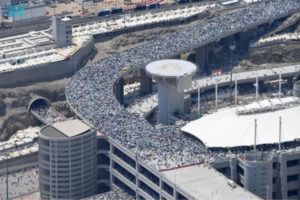
Saudi arcade
Work began in the Saudi corridor since the era of the founding King Abdulaziz Al Saud – may God have mercy on him – and his righteous sons after him continued this interest until the prosperous era of the Custodian of the Two Holy Mosques King Salman bin Abdulaziz Al Saud and His Highness the faithful Crown Prince – may God protect them – to be a source of pride for the Kingdom of Saudi Arabia. Over time.
The Saudi Corridor includes a project to expand the Mataf behind the Abbasid Corridor, surrounding it and the courtyard of the Holy Kaaba, which came about when King Abdulaziz – may God have mercy on him – ordered the construction of an expansion of the Grand Mosque to accommodate the increasing number of pilgrims, and work began on it during the reign of King Saud in 1375 AH / 1955 AD, and the construction of the Corridor continued. During the era of King Saud, King Faisal, and King Khalid – may God have mercy on them -, its development was completed during the era of Kings Fahd and Abdullah – may God have mercy on them -, and until the prosperous era of the Custodian of the Two Holy Mosques, King Salman bin Abdulaziz Al Saud and His Highness the Trustworthy Crown Prince – may God protect them -.
The Saudi Corridor surrounds the Abbasid Corridor to complement it, and is distinguished by a wider area that the Grand Mosque has never seen before, as it consists of (4) floors, namely the ground floor, the first floor, the second “mezzanine” floor, and the roof. The capacity of the Saudi Corridor has become (287,000) worshipers. And (107,000) Tawaif per hour in the hall and the courtyard.
The Saudi Corridor provides wider spaces for worshipers and devotees, according to high-quality and precise engineering standards, and is distinguished by the availability of all technical and utility services and sound and lighting systems, which contribute to creating a humble faith environment for the guests of God.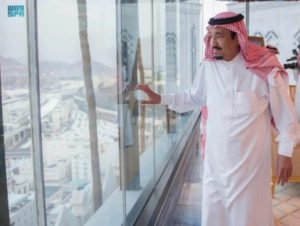
Five projects
In continuation of the approach of the kings of this blessed country; In the year 1436 AH, the Custodian of the Two Holy Mosques, King Salman bin Abdulaziz Al Saud – may God protect him – inaugurated five major projects within the comprehensive project for the third Saudi expansion, which are the main expansion building project, the squares project, the pedestrian tunnels project, and the central services station project for the Grand Mosque, and the third Saudi expansion includes ( 4) Lighthouses with a height of (135 metres), and the number of planetariums in the expansion building is (12) moving planetariums and (6) fixed planetariums, and the number of escalators in the entire project is (680) ladders to facilitate the movement of visitors, and the surface area of the entire project is estimated at (1,371,000 m2).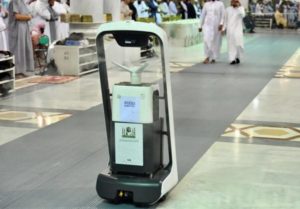
Guests of God service program
The Hajj and Umrah system has witnessed major successes year after year, within effective partnership between all security, health and logistical authorities, as one of the most important achievements that the Saudi state is proud to have achieved, thanks to God Almighty, and then with what the government of the Custodian of the Two Holy Mosques and His Highness the Trustworthy Crown Prince – may God protect them – have harnessed. – From the material and human capabilities to serve the guests of the Most Merciful and provide the opportunity for the largest number of Muslims to come to perform the Hajj and Umrah rituals and visit, and for this purpose the Custodian of the Two Holy Mosques King Salman bin Abdulaziz Al Saud – may God protect him – launched the program for serving the guests of the Most Gracious as one of the programs to achieve Saudi Vision 2030, with the aim of Raising the level of services provided to them, and enriching their religious and cultural experience.
The program for serving the guests of God embodied its integration and cooperation with 70 entities in the governmental, private and non-profit sectors to enrich and deepen the experience of pilgrims and pilgrims, by preparing the Two Holy Mosques, preparing tourist and cultural sites, and providing the best services before, during and after their visit to Mecca, Medina and the Holy Sites, and reflecting the honorable image. And the civilization of the Kingdom in the service of the Two Holy Mosques.
The Royal Commission for Mecca and the Holy Sites revealed the inventory of 20 historical sites in Mecca and the Holy Sites, explaining that the number of historical sites in Mecca is estimated at hundreds, as it is working to register them in the National Register, after verifying the content with the King Abdulaziz Foundation and the Ministry of Culture, where it is being conducted. Work to implement the governance agreed upon in the Historic Sites Committee for the Guests of God Service Program, which includes the Ministry of Culture, the Royal Commission for the City of Makkah and the Holy Sites, the Ministry of Hajj, the Secretariat of the Holy Capital, the Ministry of Tourism, the General Authority for Endowments, the King Abdulaziz Palace, and the City Development Authority. Al-Munawwarah, and the Municipality of the Medina region.
The Guests of God Service Program aims to bring about a new qualitative shift that meets the ambitions of the Guests of God, and to provide services that help them perform the rituals with ease and ease, by achieving three strategic goals: facilitating hosting more Umrah pilgrims, facilitating access to the Two Holy Mosques, and providing quality services to pilgrims. and pilgrims, enriching their religious journey and cultural experience.
The program plan includes more than 130 initiatives that were prepared by more than 30 government agencies. During the preparation and planning stage, the program also worked on tracking the journey of the Hajj and Umrah pilgrim “from idea to memory.” 192 points of contact with the guests of God were studied, and they were determined based on Field studies of every point through which Hajj and Umrah pilgrims pass, and the opinions of more than 20,000 Muslims in more than 20 countries and 135 cities were surveyed to identify their aspirations.
The sample included those who had previously performed Umrah or Hajj, in addition to those who had not previously performed, and based on the results, work was done with the relevant authorities to launch initiatives and projects that achieve the objectives of the program, as it includes a list of objectives of the “Kingdom’s Vision 2030” under the supervision of His Royal Highness Prince Mohammed bin Salman. bin Abdulaziz, Crown Prince, Deputy Prime Minister and Minister of Defence, intensive work to facilitate hosting increasing numbers of pilgrims with a flexible capacity, leading to receiving 30 million pilgrims annually by 2030.
The role of the program is not limited to developing services related to rituals, but rather aims to enrich the experience of the guests of God through the rehabilitation and development of more than 40 historical and archaeological sites, and the establishment of interactive museums and exhibitions that simulate the most prominent Islamic historical events, such as the Migration Route initiative, which pilgrims and pilgrims can enjoy visiting and watching.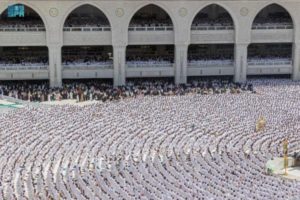
Development of the Hajj and Umrah system
The Hajj and Umrah system has developed during the past few years several important developments due to the high priority that the Hajj and Umrah sector represents, which helped launch many initiatives to organize the sector and improve the quality of services in it, such as making electronic visas available to pilgrims and Umrah performers from all countries, and extending the period of the Umrah season, And the launch of the Makkah Bus Project and the development of Islamic historical sites, and facilitating the arrival of pilgrims from outside the Kingdom through a number of visas, such as: the tourist visa when coming to the Kingdom’s ports, the electronic tourist visa, visit visas, and other types, in addition to the initiatives of the Ministry of Hajj and Electronic Umrah – such as The “Umrahna” application, the “Smart Hajj Cards”, the Hajj without a bag initiative, as well as the “Makkah Road Initiative” in partnership with several parties to facilitate the entry procedures for the guests of Rahman through the ports without waiting, and other initiatives and services aimed at serving the pilgrims, and performing their duty in every way. Ease and reassurance in an atmosphere of faith.
The Holy Sites train integrates with the rest of the services of the transportation system and logistics services provided by the Kingdom to the guests of the Sacred House, through an integrated service system that reflects the Kingdom’s interest in facilitating the movement of the flow of pilgrims and facilitating them with ease and ease according to the highest standards of quality and safe transportation, and aims to reduce traffic congestion and facilitate movement in a manner Safe and fast.
And with the desire of the Kingdom to make it possible to perform Hajj this year 1444 AH for the largest possible number of Muslims, the Council of Ministers announced in its session that it held under the chairmanship of the Custodian of the Two Holy Mosques King Salman bin Abdulaziz Al Saud – may God protect him – on January 10, 2023 AD, the return of the number of pilgrims in this season. The year 1444 AH/2023 AD to what it was before the Corona pandemic.
According to the data of the General Authority for Statistics, the total number of pilgrims since the Authority started the statistics process in the year 1390 AH under the name of “General Statistics and Information Authority”, until the last year 1443 AH, is more than (99 million pilgrims), and it goes without saying that the wise leadership – supported by God – It spared no effort to provide everything that would serve the pilgrims of the Sacred House of God and increase the absorptive capacity, as Saudi Vision 2030 stated in one of its goals to receive more than 30 million Umrah pilgrims in the year 2030.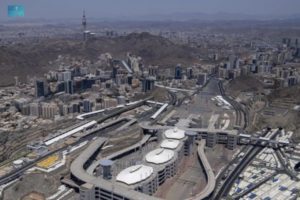
city visions
The 93rd anniversary of the unification of the Kingdom at the hands of the founder, King Abdulaziz – may his soul rest in peace – and Al-Madinah Al-Munawwarah region, like other regions of the Kingdom, are moving steadily along the path of developmental construction and hard work to serve its residents through countless continuous development projects targeting the citizen’s well-being and achieving prosperity in line with the vision Kingdom 2030, and among those projects is the Visions of the City project, which is being implemented east of the Prophet’s Noble Mosque, after His Royal Highness Prince Muhammad bin Salman bin Abdulaziz, Crown Prince, Chairman of the Council of Economic and Development Affairs and Chairman of the Board of Directors of the Public Investment Fund – may God protect him – announced the launch of infrastructure works and the general plan. For the project, which is being developed and implemented by Rou’a Al-Madina Holding Company, wholly owned by the Public Investment Fund, which is concerned with real estate development in Al-Madinah Al-Munawwarah.
The project, which is being implemented according to the highest international standards, is an implementation of the Fund’s efforts aimed at developing promising sectors in accordance with the objectives of the Kingdom’s Vision 2030 in raising the capacity to facilitate hosting 30 million pilgrims by 2030, which reflects the Kingdom’s keenness to raise the level of services provided to pilgrims in Medina as an Islamic destination. And a modern cultural one, as the project, which is built on a total area of 1.5 million square meters, is characterized by the aim of establishing 47 thousand hospitality units, in addition to open squares and green areas that facilitate visitors’ access to the Prophet’s Mosque, as 63% will be allocated as open areas and green spaces. of the project area, with many integrated solutions for transportation, including 9 bus stations for visitors, a metro train station, a path for self-driving vehicles, and underground parking, in order to facilitate the movement of visitors to the Prophet’s Mosque, which contributes to supporting residential and commercial activity, as well as providing many job opportunities.
The project, which will provide more than 93,000 direct and indirect jobs and add at least 140 billion riyals to the local economy, aims to improve the services provided to pilgrims, pilgrims, and visitors to Madinah as a modern Islamic and cultural destination, as it relies on modern urban planning mechanisms, comprehensive development concepts, and advanced infrastructure that It provides innovative services that contribute to improving the quality of life and enhances comfort and well-being, thus enriching the experience of the residents and visitors of Madinah, which enhances the level of services provided to them and raises hotel capacity and quality of services east of the Prophet’s Noble Mosque.
